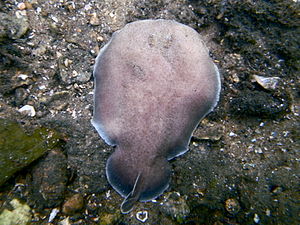Pear Electric Ray
| Pear Electric Ray | ||||||||||||
|---|---|---|---|---|---|---|---|---|---|---|---|---|

Pear Electric Ray ( Hypnos monopterygium ) |
||||||||||||
| Systematics | ||||||||||||
|
||||||||||||
| Scientific name of the family | ||||||||||||
| Hypnidae | ||||||||||||
| Gill , 1862 | ||||||||||||
| Scientific name of the genus | ||||||||||||
| Hypnos | ||||||||||||
| Duméril , 1852 | ||||||||||||
| Scientific name of the species | ||||||||||||
| Hypnos monopterygium | ||||||||||||
| ( Shaw , 1795) |
The pear-electric ray ( Hypnos monopterygium ) is a ray species from the family of the torpedo and the only member of the genus Hypnos . It is endemic to the coasts of Australia . Its exact distribution area extends from the southern coast of Queensland , along the south of the continent to the northwest coast of Western Australia . It is rare on the shores of Victoria and is absent around Tasmania .
features
The pear electric ray becomes 70 to 92 centimeters long. His body looks like it is composed of two discs. The head, torso and pectoral fins form the first, the pelvic fins the second. On the second sit two small dorsal fins, closely followed by the extremely short tail, at the end of which sits a caudal fin resembling the dorsal fins. The top of the pear electric rays can be light brown, gray, or black.
Way of life
The ray lives near the coast and is usually buried in sand or mud to a depth of 240 meters. He is lazy and feeds on crabs, worms and fish, which he numbs with electric shocks (Greek ὕπνος god of sleep).
In order to eat larger prey, it can stretch its mouth a lot. Like all electric rays, the pear electric ray is ovoviviparous . Animals washed up on the beach can survive for hours.
literature
- E. Lieske, RF Myers: Coral fish of the world . 1994, year publisher, ISBN 3-86132-112-2
Web links
- Pear Electric Rays on Fishbase.org (English)
- Hypnos monopterygium at Australian Museum Fish Site (English)
- Hypnos monopterygius in the Red List of Threatened Species of the IUCN 2013.1. Submitted by: Lisney, TJ (SSG Australia & Oceania Regional Workshop, March 2003), 2003. Retrieved November 2, 2013.
Individual evidence
- ^ Hypnos monopterygium at Australian Museum Fish Site
- ^ Australian Museum online photo of a pear electric ray that choked on a porcupine fish
